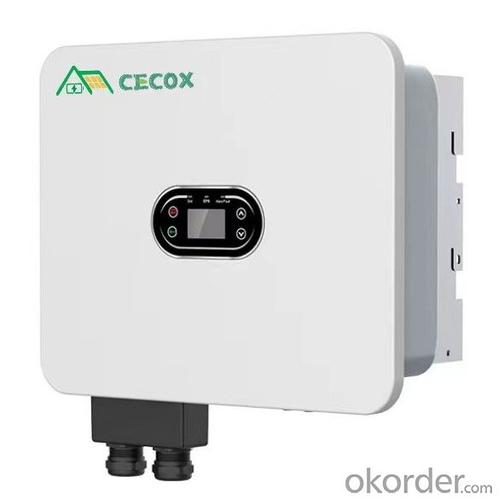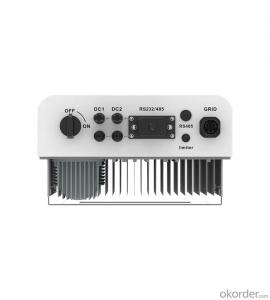Single Phase Hybrid Solar Inverter 3KVA-6KVA/5.5-9KW
- Loading Port:
- China main port
- Payment Terms:
- TT OR LC
- Min Order Qty:
- 1 unit
- Supply Capability:
- 10000 unit/month
OKorder Service Pledge
OKorder Financial Service
You Might Also Like
Specification
Industry-specific
Output Type:Single, Pure Sine Wave
Type:DC/AC Inverters
Inverter Efficiency:97.5%
Other attributes
Place of Origin:China
Model Number:XD3KTL, XD4KTL, XD5KTL, XD6KTL
Input Voltage:40V~60V DC
Output Voltage:230V AC
Output Current:15~27.3A
Output Frequency:50Hz / 60Hz
Size:490W*395H*200D mm
Certificate:CE/IEC/ISO/TUV
IP66
Warranty:5 years
Weight:20kg
Product Name:3KVA 3.68KVA 4KVA 4.6LVA 5KVA 6KVA CNBM Hybrid Solar Inverter
Battery Type:Lithium/Lead-acid
Rated Power:3000~6000W
Waveform:Pure Sine Wave
Power Factor:0.8 leading~0.8 lagging
Max. PV Input Power:4.5~9kW
Max. PV Input Voltage:600V
Max. PV Input Current:16A
Communication:RS485 / CAN / WIFI / 4G / LAN / Bluetooth
Certifications:IEC/EN 62109-1/2, IEC/EN 61000-6-1/3, IEC61727/IEC62116, EN50549, CEI0-21, C10/C11, VDE4105, VDE0126, G98/99, RD244,UNE217001, UNE217002,AS4777, NRS097-2-1
Packaging and delivery
Package Type:Standard Export Package
Supply Ability:10000 Piece/Pieces per Month
Lead time
Quantity (pieces) 1 - 100 101 - 500 501 - 1000 > 1000
Lead time (days) 7 14 21 To be negotiated
Customization
Customized packaging:MOQ1000sets
- Q: What is the impact of temperature on the performance of a solar inverter?
- The impact of temperature on the performance of a solar inverter is significant. As temperature increases, the efficiency of the inverter tends to decrease. This is because higher temperatures can lead to increased resistive losses, increased internal losses, and decreased power conversion efficiency. Additionally, overheating can cause the inverter to shut down or operate at reduced capacity to prevent damage. Therefore, it is important to consider temperature management and cooling strategies to optimize the performance and lifespan of a solar inverter.
- Q: What are the potential risks of overloading a solar inverter?
- Overloading a solar inverter can lead to several potential risks. Firstly, it can cause the inverter to overheat, which can result in damage to the internal components and reduce its lifespan. Secondly, overloading can cause the inverter to shut down or trip, interrupting the solar power generation and potentially causing a power outage. Additionally, overloading the inverter may also compromise the safety of the electrical system, increasing the risk of electrical fires or other hazards. Therefore, it is important to ensure that the solar inverter is properly sized and not overloaded to avoid these potential risks.
- Q: How is the efficiency of a solar inverter measured?
- The efficiency of a solar inverter is typically measured by comparing the amount of direct current (DC) power produced by the solar panels to the alternating current (AC) power delivered by the inverter. This measurement is known as the inverter efficiency and is expressed as a percentage. The higher the efficiency, the more effectively the inverter converts DC power into usable AC power, resulting in greater overall energy production from the solar system.
- Q: What is the cost of a solar inverter?
- The cost of a solar inverter can vary depending on the brand, size, and features. On average, a basic solar inverter can range from $500 to $2000. However, more advanced or larger capacity inverters can cost upwards of $5000. It is important to consider the quality and efficiency of the inverter when determining its cost as it plays a crucial role in the overall performance of a solar power system.
- Q: Can a solar inverter be used in a mobile or portable solar power system?
- Yes, a solar inverter can be used in a mobile or portable solar power system. Solar inverters are designed to convert the DC (direct current) electricity generated by solar panels into AC (alternating current) electricity that can be used to power various devices. In a mobile or portable solar power system, the solar inverter plays a crucial role in converting the energy collected by the solar panels into a usable form for powering appliances or charging batteries.
- Q: How do you size a solar inverter for a solar power system?
- To size a solar inverter for a solar power system, you need to consider the maximum power output of the solar panels and the total load you want to power. The inverter's capacity should be equal to or greater than the total power output of the solar panels to ensure efficient energy conversion. Additionally, you should also consider the voltage and current requirements of the load to ensure compatibility with the inverter. It is recommended to consult with a professional or use online sizing tools to accurately determine the appropriate inverter size for your specific solar power system.
- Q: PV grid-connected inverter and independent inverter in the control of what is the difference
- The independent inverter in the output voltage phase amplitude of the frequency control is initially set good. Independent inverter, you should refer to off-grid inverter, do not need to consider the grid situation.
- Q: Can a solar inverter be used in areas with high electromagnetic radiation?
- Yes, a solar inverter can be used in areas with high electromagnetic radiation. However, it is important to note that the performance and reliability of the inverter may be affected by the presence of high electromagnetic radiation. High radiation levels can potentially cause electromagnetic interference (EMI) which may disrupt the functioning of the inverter and lead to reduced efficiency or even failure. Therefore, it is recommended to take necessary precautions such as proper grounding, shielding, and selecting inverters with robust EMI protection mechanisms when installing solar inverters in areas with high electromagnetic radiation. Additionally, it is advisable to consult with experts or manufacturers who can provide guidance on specific models of solar inverters that are designed to withstand and perform well in high electromagnetic radiation environments.
- Q: What are the advantages of using a transformerless solar inverter?
- One advantage of using a transformerless solar inverter is increased efficiency. Transformerless inverters have a higher efficiency rating compared to inverters with transformers, which means more of the solar energy is converted into usable electricity. Additionally, transformerless inverters are lighter and more compact, making them easier to install and transport. They also tend to have a longer lifespan and require less maintenance compared to inverters with transformers.
- Q: What is the role of a cooling system in a solar inverter?
- The role of a cooling system in a solar inverter is to regulate and maintain optimal operating temperatures to prevent overheating. This is crucial because excessive heat can degrade the performance and lifespan of the inverter, leading to reduced efficiency and potential failure. The cooling system helps dissipate heat generated by the inverter's components, ensuring smooth and efficient operation, and ultimately enhancing the overall reliability and longevity of the solar inverter.
Send your message to us
Single Phase Hybrid Solar Inverter 3KVA-6KVA/5.5-9KW
- Loading Port:
- China main port
- Payment Terms:
- TT OR LC
- Min Order Qty:
- 1 unit
- Supply Capability:
- 10000 unit/month
OKorder Service Pledge
OKorder Financial Service
Similar products
Hot products
Hot Searches
Related keywords


























